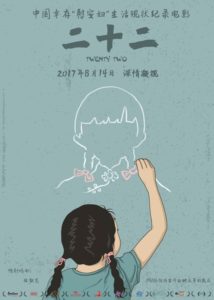Twenty Two
二十二
China, 2015, colour, 2.35:1, 99 mins.
Director: Guo Ke 郭柯.
Rating: 5/10.
Compassionate but over-long portrait of China’s handful of surviving “comfort women” from WW2.
A portrait of the (then) 22 surviving Chinese who were forced to work as “comfort women” 慰安妇 by the Japanese military during the Sino-Japanese War (1937-45), including interviews with some of them and those who now care for them.
REVIEW
There’s no shortage of documentaries on the Japanese army’s use of “comfort women” 慰安妇 (a Japanese term) during WW2 and, with the government still refusing to apologise or pay any compensation, it remains a sensitive issue throughout East Asia. Anyone expecting another trawl through the historical evidence, plus interviews with survivors, will be disappointed by Twenty Two 二十二: the documentary focuses on China and contains only the basic, well-known facts. Instead, it shows the daily lives of a handful of the survivors – 22 by the end of filming in 2014, only nine now. Though the subject remains an important one, as a feature-length documentary it hardly sustains its length; despite that, it’s become the surprise summer hit of the Mainland box office, making some RMB160 million (way more than most commercial movies) in a fortnight.
The film is a spin-off from Thirty Two 三十二 (2013), a 43-minute documentary by the same director, Guo Ke 郭柯, that focused on one survivor, Wei Shaolan 韦绍兰 (1920- ), from the Yao minority in Guangxi province, and Luo Shanxue 罗善学 (1945- ), her half-Japanese son from the experience. The film ended by listing all 32 Chinese survivors of the time (down to 25 by the time the film was released). Twenty Two spreads its net broader by visiting all survivors and was first shown at the Busan film festival in Oct 2015 in a 112-minute version. The tighter, updated version now on release in China was prepared by veteran Taiwan editor Liao Qingsong 廖庆松, though the film would lose nothing by being further cut back to around an hour.
Most of the basic facts are conveyed by on-screen captions: in China alone, some 200,000 women were forced to become sex-slaves for the Japanese army; the military brothels were run by Japanese professionals or sometimes Koreans; most women were tortured to death or committed suicide; survivors were later (and especially during the Cultural Revolution) vilified by Chinese as “race traitors” 汉奸 or “Japanese wives” 日本娘; and silence became the norm. Unfortunately, that’s the film’s problem: most don’t want to talk about their experiences, even 70-plus years on, so almost all are represented by just a few shots and a name caption, generally in their simple rural homes.
Some that agreed to talk do so fitfully and very emotionally, often breaking down or breaking off. Others are less emotional and slightly more informative: in an old people’s nursing home in Hainan island, the feisty Lin Ailan 林爱兰 (1925-2015) talks of being in the communist resistance and then being held captive for two years and forced to marry a Japanese soldier; in a Hainan village, where she’s well cared for by her family, Li Meijin 李美金 (1926- ) talks of being forced while a teenager to climb trees to pick fruit at bayonet point but doesn’t mention any personal atrocities; in Shanxi province, Li Ailian 李爱连 (1928- ) talks of making shoes for the Japanese and being beaten but also remains silent on the subject of forced sex.
As a strict documentary on its subject, Twenty Two is very hit-and-miss, poorly organised, and with no clear structure – apart from being bookended by the funeral of one survivor, Chen Lintao 陈林桃, in rural Shanxi province in 2014. The ruins of a “comfort station” (army brothel) are shown in Shanxi and a South Korean photojournalist, An Se-hong 안세홍 | 安世鸿, who’s been researching mostly Korean victims, is interviewed, leading to the case of Mao Yinmei 毛银梅 (1922-2017), an ethnic Korean born as Bak Cha-sun 박차순 | 朴车顺, who’s looked after by her Chinese adopted daughter in Wuhan city. Mao, however, says little and prefers reminiscing about a Korea she’s never returned to.
Poetic shots of rain and so on between the portraits also don’t add anything. Where the documentary is most successful is as a portrait of modern-day family/community support (or not) for the victims and how rapidly they are now dying off. In a couple of years there will literally be none left – further burying the whole story in the mist of history, as many (on both Chinese and Japanese sides, for their own reasons) would like. At the end of the day that’s the real tragedy which Twenty Two underlines.
Technical credits are good, with clear photography by Cai Tao 蔡涛 in widescreen as in Thirty Two, though more naturalistic this time (to its credit). Only at the very end is there music, a smattering of solo piano.
CREDITS
Presented by Sichuan Light & Shadow Cultural Communication (CN), Beijing Golden World Movies & TV Culture (CN).
Photography: Cai Tao. Editing: Liao Qingsong, Xiang Yang. Sound: Chen Zhifu, Kang Weidong.
With: An Se-hong, Mao Yinmei [Bak Cha-sun], Huang Meirong, Lin Ailan, Li Meijin, Li Ailian, Luo Shanxue, Chen Houzhi.
Premiere: Busan Film Festival (Wide Angle Documentary Competition), 5 Oct 2015 (112 mins.).
Release: China, 14 Aug 2017.
